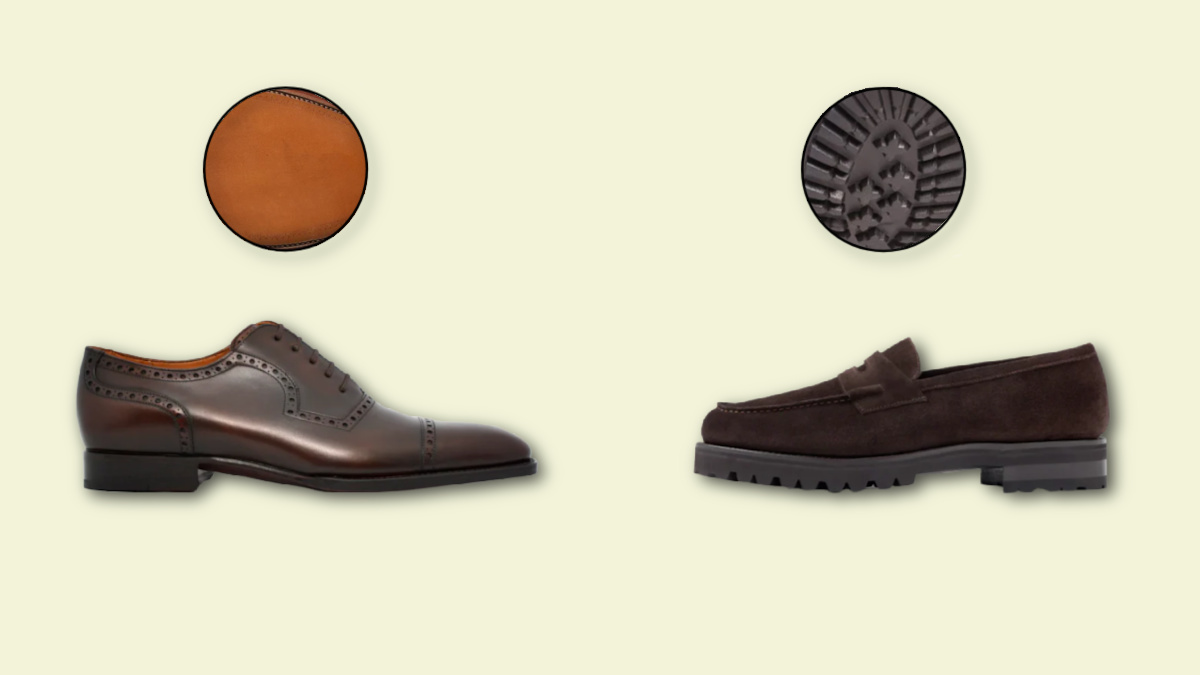For a traditionally dressy look, leather soles are definitely more formal. Function-wise, rubber is naturally stronger, grippy, and is immediately flexible. Meanwhile, good, broken-in leather soles conform to your feet and gait. They can be made more durable, but are heavier than rubber soles.
Ah, the paradox of choice.
I’m not opposed to having options, but life is always easier when things are a given. Like dress shoes, for example.
For centuries, dress shoes meant leather outsoles. Even a lot of the hybrid models in years past were outfitted with blatantly casual rubber outsoles. Of course, they weren’t fit for any boardroom, much less any formal setting.
These days though, both rubber-soled dress shoes and leather-soled dress shoes can seem visually interchangeable, at first glance that is.
The devil is in the details though, so here are the details to help you decide which you should get for what occasions.
Table of Contents
Leather vs Rubber Soles: Which Should You Get?
Leather Soles: Pros and Cons
Man has been making outsoles out of leather since the Middle Ages, then a premium choice available mainly to the upper echelons of society.
By the 18th century, industrialization allowed leather to be efficiently produced and sold. Suffice to say, leather has been a default shoe material for thousands of years, but this ramped it up. It’s still the go-to for dress shoes, but let’s take a look at some pros and cons.
Pros of Leather Soles
Leather Can Be Durably Built
We’ll get more into the fact that rubber is actually naturally stronger, but leather gets exponentially more durable the more you layer it. A triple leather sole, as its name suggests, is one in which three layers of leather are stacked to create the sole. It’s a definite gold standard and can outperform most rubber outsoles.
Toe taps, which are metal plates added to the bottom of the shoe right at the toe area, can fortify a double leather sole so that it’s just as long lasting as a triple leather. If toe taps are added to a triple leather, you’ve got the strongest, albeit heaviest, type of leather dress shoe sole.
The way the shoe is constructed will also increase its life expectancy. A Goodyear welt, for example, securely attaches the already naturally sturdy leather sole to the upper, and also provides easy resoling capabilities when the time comes.
Keep in mind that the more of the fortifying features a leather outsole has, the more premium (read: expensive) it will be.
Leather Outsoles Are More Formal
Since we’re talking about dress shoes here, the more formal the look, the better. A leather outsole is the traditional choice for evening wear.
It looks elegant from every angle, and all things considered, it’s also more versatile. You can wear a visible rubber outsole with casual, smart casual, and professional attire. You can do the very same with a leather outsole, while expanding the range into cocktail, and formal or black-tie situations.
Leather Outsoles Provide (Eventual) Personalized Comfort
Once you’ve broken in your leather-soled dress shoe, it can be as comfortable as a sneaker. And depending on the sneaker, maybe moreso.
I think of a well-built leather outsole as like a horse that needs taming. If you take the time to break him in, and if you do it right, he’ll serve you specifically the way you, personally, need to be served.
Perhaps a gross reality, but leather is just skin at the end of the day. That being the case, it will conform to your exact foot shape and take into account your unique gait. If the shoe also has a cork midsole, it’ll eventually become pretty flexible as well.
Cons of Leather Soles
They Require More Breaking In
As mentioned, a leather sole will need far more breaking in than a rubber one. Even thinner soles, if they’re made out of real leather, will often start out pretty stiff.
Even worse, if a manufacturer isn’t straight-forward about the build of the shoe, you might come out on the other side of the break-in process with a stiff, flat, supportless sole.
Your best bets are brands that are forthcoming about their construction and processes, or at least ones with a lot of reviews that you can dig through.
They’re Not as Naturally Strong
As a raw material, leather isn’t stronger than rubber by any means. So while I mentioned that there are ways in which shoemakers can make leather a more lasting sole material, it can’t be done on its own.
As such, good leather soles are often more pricey. Compare that to naturally cheaper and naturally more durable rubber.
Leather will also absorb water over time, and overexposure can cause it to crack and wear out more. They’re not great outsole material when it comes to weather. When it’s raining out, I tend to wear rain boots during my commute to work and keep my dress shoes in my bag.
A Well-Built Leather Outsole Is Relatively Heavy
Leather is already naturally heavier than rubber.
Even more, if you do pay the premium for a classic leather sole with all of the extra strength features, you’re looking at layers of leather, extra stitching, pieces of metal, and possibly a heel cap.
Outside of the boot category, this is typically as heavy as a shoe can get.
Rubber Soles: Pros and Cons
In the late 1800s, Charles Goodyear Sr. figured out the vulcanization technique, which strongly bonds rubber to other components. Thanks to this, rubber-soled shoes were developed.
Rubber soles were (and are) a lighter, grippier option over leather, which makes them perfect for performance shoes and work boots.
Relatively recently, they’ve been used for hybrid dress shoes, a few models even passing for traditional soles depending on where you’re looking at them from. Here are the specific pros and cons of rubber soles on dress shoes.
Pros of Rubber Soles
Rubber Soles Are Naturally Stronger than Leather Soles
A rubber sole isn’t just overall more durable than a leather sole, but it’s also weather resistant and naturally shock absorbent. After all, rubber is the same material used for car tires and gaskets.
As far as weather resistance, unlike porous leather, there aren’t any pathways for water to seep into rubber, keeping rain and mud damage at bay.
One of the features that makes this material so unique is that it has a combination of adhesive qualities and elastic qualities. Basically, its natural bounce deflects and dampens shock, while also storing energy.
Not only will you have a better time in the rain with a rubber sole, but on cobblestone streets as well.
Rubber Soles Are Grippy
And speaking of its adhesive qualities, you’ll get far more traction with a rubber sole than a leather one. One hack often implemented onto leather soles is adding a rubber heel cap for extra traction. However, it’ll never grasp the floor as well as naturally grippy rubber does.
If you’re looking to avoid slippage, rubber is the way to go. At my office, there’s a flight of infamously slippery marble stairs. On days that it’s raining heavily, and if I know I don’t have any formal meetings, I often opt for rubber-soled dress shoes so I don’t break my neck on said stairs.
Rubber Soles Are Light and Flexible
Not only is rubber stronger than leather, but it’s lighter too. The natural flex also makes a rubber-soled shoe a lot more comfortable than a leather one right out of the box, even if it’s fully welted.
All things considered, rubber-soled dress shoes generally have a far shorter break in time than their leather-soled counterparts. Many don’t need to be broken in at all.
So if you’re looking for dress shoes that you want to wear right out of the box, especially in a situation that has you on your feet for long periods of time, go for a rubber sole.
Cons of Rubber Soles
They Won’t Conform to Your Feet as Deeply
Sure, with a rubber sole you get instant gratification on the comfort front. In the long run though, a leather sole will perfectly accommodate the contours of your feet down to its core.
With a rubber sole, the insole might conform to you, but that’s as far as it goes. The rubber won’t change shape, will stay rigid, and will likely get less comfortable over time. It’s essentially doing the exact opposite of what a leather sole does.
No Rubber Sole Will Look as Formal as a Leather Sole
I’m not going to deny that there are pretty good rubber soles on the market that can pass as leather ones unless you looked at them up close. And fortunately, very rarely will another human being’s face ever be that close to your shoes.
Still, as the bottoms peak out while you walk, tell-tale signs of rubber construction may be visible. A well-disguised rubber sole is like a really good clip-on tie. You probably don’t want that quality of it revealed, and some eagle-eyed bystanders might notice.
This doesn’t matter to everyone, but if it matters to you, stick to leather soles.
They Aren’t as Resilient
I know I mentioned that rubber is more durable than leather, but here’s what I mean by resilience.
Leather soles may wear out over time, but just one crack on your rubber sole, and it’s done forever. And if it isn’t welted, that entire shoe is done forever.
It’s sort of like getting a flat tire. Rubber is strong, but once punctured, it’s time for a replacement.
Your Sole Objective
Choosing between a rubber sole and a leather sole for your dress shoe depends on your priorities and objectives.
If you want to adhere strictly to tradition, but don’t want to sacrifice comfort, you’ll need to gather the time and money necessary. Invest in a good, thick leather-soled dress shoe, but take the time to break it in so that it conforms to your feet.
If immediate comfort, flexibility, or overall performance are your priorities, a rubber sole is the better option.
Here’s the thing though.
There’s room for both soles in your rotation, particularly if you go for a more discreet rubber sole. You might save the rubber-soled model for casual Fridays, use them as your commuting shoes, or wear them to dress-code-appropriate events that require you to be on foot.
Then, go full leather for occasions that are extra formal, fully professional, or won’t require you to stand or walk much.
FAQs
Is leather stronger than rubber?
Rubber is naturally stronger than leather, though shoemakers often strengthen their leather soles with several layers of the material and other fortifications. Still, rubber remains more weather resistant.
Do leather soles last?
No sole lasts forever, but a thicker, multi-layered leather sole can last years longer than a thinner leather sole. Adding metal toe taps and rubber heel caps will add even more life to the sole.
What is the best material for the bottom of shoes?
For a more formal look, leather is better. It’s also better when it comes to accommodating your foot contours and stride. Meanwhile, rubber is better when it comes to making soles that are immediately comfortable, grippy, durable, and weather resistant.


Join the Discussion